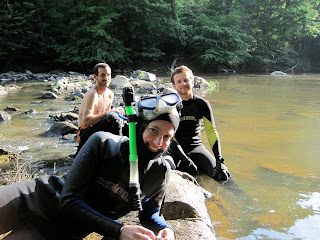
Hello All,
First before I begin posting about my field work, I would like to thank you all for taking the time out of your busy schedules to read about my adventures in the field. The content of this blog is suppose to be humorous as well as educational. Hopefully, I will manage to get both points across.
The Month of July.
Recently, as in the beginning of July, I decided to begin a blog. Shortly after, several note worthy experiences happened in the field, which I couldn't wait to blog about. I will get to these later. However, as irony would have it, my computer and all my electronics were stolen out of my hotel room in Louisburg, NC. Therefore, many of the stories told in this posting have occurred over the entire month of July.
First: a little more detail about my job.
I am working with several amazing people on several different projects. First, I am working with a mussel crew based in NC examining the effects of mill dams on freshwater mussel densities and diversities. The second crew, which is basically a blend of the first, is examining fish communities in the same locations. The first two jobs are projects run by Masters students. I also bounce around on a few projects in Alabama and Florida. These projects are usually funded by the government. Lastly, I am beginning my Master's work on how beavers affect freshwater mussels in NC.
Second: a little information about why I study freshwater mussels.
Most people, as you will soon find out in this blog, don't know about freshwater mussels let alone know that they are one of the most imperiled group of organisms on the planet. And this is perfectly fine. They're not fluffy pandas or floppy eared elephants. They are not cool cats or dangerous predators. They tend to "clam-up" when you grab them. They don't purr, try to kill you, or have flashy feathers. In fact, they are mostly small sessile rocks that suck up dirt and water from the river bottom and spit it back out. As our lab likes to say, "they are rocks that suck". But at the same time, these sucking rocks filter the water. They help to make the water clear and pure. They are one of the first organisms to die in the presence of pollution (whether that be chemical runoff from a parking lot with motor oil, fertilizers, PCB's, lead, the list goes on on on) or physical disturbances (sediment runoff from that cool new river house, channelization of the stream, destabilized banks, that also goes on and on on). These little almost unnoticeable "rocks" do a lot to improve our waters. They are also pretty neat. They may not be able to bite your head off, but they can do that to a fish (Epioblasma triquetra "The Snuffbox"). Nearly all (except for Simpsonaias ambiguia "The Salamander Mussel") are parasitic on fish. Mussels make extensions from their mantle (the fleshy part covering their gills) that look like bait fish, worms, and crayfish. These lures encourage fish to swim close to the mussel to check out the "snack". Once the fish is close enough, the mussel (depending on the species) will either bite or spray larval mussels (glochidia) on the fish's face. Some mussels also make superconglutonates and conglutonates that are filled with glochidia. These packages also tend to resemble fish, aquatic insects, and even leaches. So, they might not be the cutest endangered animal on the planet, but I think they are pretty cool and important. Hopefully, you do too.
That's the basics on mussels and my field work. Now that you know some of the background, lets get into the good stuff! The field work.
Well.. unfortunately... the rain has stopped here in Wewahitchka, Fl. So back to the field. The stories will have to wait.



No comments:
Post a Comment